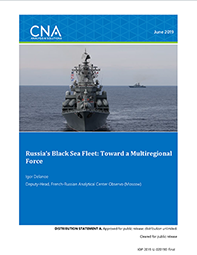The Black Sea Fleet has played a role in all three of the latest military expeditions undertaken by Russia. Although their involvement was limited, some surface units were mobilized during the August 2008 Russia-Georgia war to form a blockade off the Georgian coast and participate in some limited combat operations. In 2014, the issue of the Black Sea Fleet and the need for full sovereignty over the Sevastopol Naval Base was a leading factor in Moscow’s annexation of the peninsula. Since 2015, the Black Sea Fleet has participated in Russia’s military intervention in Syria, not only providing key logistical support—something it has been doing since the beginning of the Syrian crisis in 2011 to support Damascus—but also carrying out combat missions and enforcing conventional deterrence against a potential NATO or Turkish action in Syria.
The Russian Black Sea Fleet has experienced deep structural changes since the end of the 2000s. During the Soviet period, it was a large blue-water naval formation, tasked with an area of responsibility encompassing not only the Black Sea but also the Mediterranean and the Indian and Atlantic Oceans. Its core mission was to challenge NATO navies’ supremacy in the Mediterranean basin, presenting a permanent threat on the alliance’s southern flank and supporting political and military-technical partnerships with third countries in the Middle East and Africa. After a period of general disarray following the collapse of the Soviet Union, the Black Sea Fleet became the center of the naval preoccupations of the Russian General Staff at the end of the 2000s. Therefore, even before the Ukrainian crisis and the subsequent absorption of Crimea by Moscow, the Black Sea Fleet had already benefited from some funding and plans that aimed at stopping the severe bleeding of capabilities. The annexation of Crimea in 2014 and its consequences (sanctions, lasting tensions with the Euro-Atlantic community, new shores to protect) completely changed the picture, compelling Russia’s Ministry of Defense to recalibrate its priorities regarding the modernization of the Black Sea Fleet.
Today, the Black Sea Fleet appears to be a more flexible and multipurpose naval formation. Its area of responsibility has evolved and is more focused on the greater Mediterranean region. Meanwhile, the Caspian Flotilla, which was of secondary importance during the Soviet era, plays a greater role and is also experiencing a military buildup, although its scale is modest in comparison with that of the Black Sea Fleet. However, Russia’s military insertion in Syria and the recent rise of tensions in the Azov basin have highlighted the porosity of the tasks undertaken by both formations. The Black Sea Fleet and the Caspian Flotilla, both arranged around the defense of a maritime bastion (the Black Sea and the Caspian Sea, respectively)tend to be merged into a single, more agile, more ubiquitous force, tasked with the protection of Russia’s southern flank, from the Caspian region to the Levant. These bastions can be used to protect Russia’s territory from the south or to carry out strikes against targets located far beyond Russia’s immediate neighborhood. This was demonstrated with the Kalibr cruise missiles fired from the Caspian Sea and the Levant by surface platforms and submarines during the Russian military campaign in Syria.
Download reportDistribution: Distribution is unlimited. Public Release. 6/5/2019
Details
- Pages: 36
- Document Number: IOP-2019-U-020190-Final
- Publication Date: 6/5/2019
